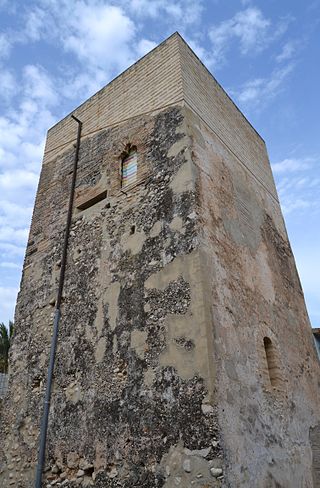
Valencia is the capital of the province and autonomous community of the same name. It is the third-most populated municipality in Spain, with 807,693 inhabitants (2023) within the Ciudad de Valencia and 1,582,387 inhabitants (2021) within metropolis of the Huerta de Valencia.. It is located in eastern Spain, on the banks of the Turia, on the east coast of the Iberian Peninsula on the Mediterranean Sea.

Valencian or the Valencian language is the official, historical and traditional name used in the Valencian Community of Spain to refer to the Romance language also known as Catalan, either as a whole or in its Valencia-specific linguistic forms. The Valencian Community's 1982 Statute of Autonomy and the Spanish Constitution officially recognise Valencian as the name of the regional language.

A province in Spain is a territorial division defined as a collection of municipalities. The current provinces of Spain correspond by and large to the provinces created under the purview of the 1833 territorial re-organization of Spain, with a similar predecessor from 1822 and an earlier precedent in the 1810 Napoleonic division of Spain into 84 prefectures. There are many other groupings of municipalities that comprise the local government of Spain.

The Catalan Countries are those territories where the Catalan language is spoken. They include the Spanish regions of Catalonia, the Balearic Islands, Valencian Community, and parts of Aragon and Murcia (Carche), as well as the Principality of Andorra, the department of Pyrénées-Orientales in France, and the city of Alghero in Sardinia (Italy). It is often used as a sociolinguistic term to describe the cultural-linguistic area where Catalan is spoken. In the context of Catalan nationalism, the term is sometimes used in a more restricted way to refer to just Catalonia, Valencia and the Balearic Islands. The Catalan Countries do not correspond to any present or past political or administrative unit, though most of the area belonged to the Crown of Aragon in the Middle Ages. Parts of Valencia (Spanish) and Catalonia (Occitan) are not Catalan-speaking.
The phonology of Catalan, a Romance language, has a certain degree of dialectal variation. Although there are two standard varieties, one based on Central Eastern dialect and another one based on South-Western or Valencian dialect, this article deals with features of all or most dialects, as well as regional pronunciation differences.
The Catalan and Valencian orthographies encompass the spelling and punctuation of standard Catalan and Valencian. There are also several adapted variants to the peculiarities of local dialects of Insular Catalan.

The Valencian Nationalist Bloc was a Valencian nationalist party in the Valencian Country, Spain. It was the largest party in the Coalició Compromís until 2021, when it was replaced in a refoundation process by Més–Compromís.

Pinoso, officially El Pinós/Pinoso is a traditional town which sits located in the mountainous countryside of the Alicante/Murcia border. This traditional town is renowned for the production of fine wines, rock salt and marble. Pinoso has a population of 7,300 and a municipal area of 126 km2. Recently it has experienced a growth in tourism.

Caudete is a municipality of Spain located in the province of Albacete, Castilla–La Mancha. It has a population of 10.163. It is part of the Altiplanicie de Almansa comarca.

The municipality is one of the two fundamental territorial divisions in Spain, the other being the provinces.

The University of Alicante was established in 1979 on the basis of the Center for University Studies (CEU), which was founded in 1968. The university main campus is located in San Vicente del Raspeig/Sant Vicent del Raspeig, bordering the city of Alicante to the north. As of 2011/12 academic year, there are approximately 27,500 students studying there.
Quatretonda is a municipality in the comarca of Vall d'Albaida in the Valencian Country, Spain.

Alt Vinalopó or Alto Vinalopó is a comarca in the province of Alicante, Valencian Community, Spain.
Valencian nationalism or Valencianism is a political movement in the Valencian Community, Spain.

The Valencian Community is an autonomous community of Spain. It is the fourth most populous Spanish autonomous community after Andalusia, Catalonia and the Community of Madrid with more than five million inhabitants. Its homonymous capital Valencia is the third largest city and metropolitan area in Spain. It is located along the Mediterranean coast on the east side of the Iberian Peninsula. It borders Catalonia to the north, Aragon and Castilla–La Mancha to the west, and Murcia to the south, and the Balearic Islands are to its east. The Valencian Community is divided into three provinces: Castellón, Valencia and Alicante.

Els Poblets, also known as Setla, Mira-rosa i Miraflor, is a municipality in the Valencian Community, Spain. It is situated in the north of the province of Alicante. The population is 3,708.

Manchuela or La Manchuela is a comarca located in Castile-La Mancha and Valencian Community, Spain.
This article is about the phonology and phonetics of the Galician language.

Joan Francesc Mira i Casterà is a Spanish writer, anthropologist and sociologist. He is an honorary member of the Associació d'Escriptors en Llengua Catalana and President of Acció Cultural del País Valencià. In politics he is a supporter and has been a candidate of Valencian Nationalist Bloc in 2000 and 2003.

Valencian Art Nouveau is the historiographic denomination given to an art and literature movement associated with the Art Nouveau in the Valencian Community, in Spain.
















